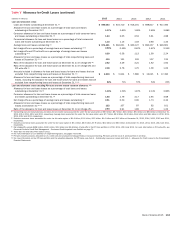Bank of America 2015 Annual Report Download - page 105
Download and view the complete annual report
Please find page 105 of the 2015 Bank of America annual report below. You can navigate through the pages in the report by either clicking on the pages listed below, or by using the keyword search tool below to find specific information within the annual report.Bank of America 2015 103
Litigation Reserve
For a limited number of the matters disclosed in Note 12 –
Commitments and Contingencies to the Consolidated Financial
Statements for which a loss is probable or reasonably possible in
future periods, whether in excess of a related accrued liability or
where there is no accrued liability, we are able to estimate a range
of possible loss. In determining whether it is possible to provide
an estimate of loss or range of possible loss, the Corporation
reviews and evaluates its material litigation and regulatory matters
on an ongoing basis, in conjunction with any outside counsel
handling the matter, in light of potentially relevant factual and legal
developments. These may include information learned through the
discovery process, rulings on dispositive motions, settlement
discussions, and other rulings by courts, arbitrators or others. In
cases in which the Corporation possesses sufficient information
to develop an estimate of loss or range of possible loss, that
estimate is aggregated and disclosed in Note 12 – Commitments
and Contingencies to the Consolidated Financial Statements. For
other disclosed matters for which a loss is probable or reasonably
possible, such an estimate is not possible. Those matters for
which an estimate is not possible are not included within this
estimated range. Therefore, the estimated range of possible loss
represents what we believe to be an estimate of possible loss only
for certain matters meeting these criteria. It does not represent
the Corporation’s maximum loss exposure. Information is provided
in Note 12 – Commitments and Contingencies to the Consolidated
Financial Statements regarding the nature of all of these
contingencies and, where specified, the amount of the claim
associated with these loss contingencies.
Consolidation and Accounting for Variable Interest
Entities
In accordance with applicable accounting guidance, an entity that
has a controlling financial interest in a variable interest entity (VIE)
is referred to as the primary beneficiary and consolidates the VIE.
The Corporation is deemed to have a controlling financial interest
and is the primary beneficiary of a VIE if it has both the power to
direct the activities of the VIE that most significantly impact the
VIE’s economic performance and an obligation to absorb losses
or the right to receive benefits that could potentially be significant
to the VIE.
Determining whether an entity has a controlling financial
interest in a VIE requires significant judgment. An entity must
assess the purpose and design of the VIE, including explicit and
implicit contractual arrangements, and the entity’s involvement in
both the design of the VIE and its ongoing activities. The entity
must then determine which activities have the most significant
impact on the economic performance of the VIE and whether the
entity has the power to direct such activities. For VIEs that hold
financial assets, the party that services the assets or makes
investment management decisions may have the power to direct
the most significant activities of a VIE. Alternatively, a third party
that has the unilateral right to replace the servicer or investment
manager or to liquidate the VIE may be deemed to be the party
with power. If there are no significant ongoing activities, the party
that was responsible for the design of the VIE may be deemed to
have power. If the entity determines that it has the power to direct
the most significant activities of the VIE, then the entity must
determine if it has either an obligation to absorb losses or the
right to receive benefits that could potentially be significant to the
VIE. Such economic interests may include investments in debt or
equity instruments issued by the VIE, liquidity commitments, and
explicit and implicit guarantees.
On a quarterly basis, we reassess whether we have a controlling
financial interest and are the primary beneficiary of a VIE. The
quarterly reassessment process considers whether we have
acquired or divested the power to direct the activities of the VIE
through changes in governing documents or other circumstances.
The reassessment also considers whether we have acquired or
disposed of a financial interest that could be significant to the VIE,
or whether an interest in the VIE has become significant or is no
longer significant. The consolidation status of the VIEs with which
we are involved may change as a result of such reassessments.
Changes in consolidation status are applied prospectively, with
assets and liabilities of a newly consolidated VIE initially recorded
at fair value. A gain or loss may be recognized upon deconsolidation
of a VIE depending on the carrying values of deconsolidated assets
and liabilities compared to the fair value of retained interests and
ongoing contractual arrangements.
2014 Compared to 2013
The following discussion and analysis provide a comparison of our
results of operations for 2014 and 2013. This discussion should
be read in conjunction with the Consolidated Financial Statements
and related Notes. Tables 8 and 9 contain financial data to
supplement this discussion.
Overview
Net Income
Net income was $4.8 billion in 2014 compared to $11.4 billion
in 2013. Including preferred stock dividends, net income
applicable to common shareholders was $3.8 billion, or $0.36 per
diluted share in 2014 and $10.1 billion, or $0.90 per diluted share
in 2013.
Net Interest Income
Net interest income on an FTE basis decreased $2.3 billion to
$40.8 billion in 2014 compared to 2013. The net interest yield
on an FTE basis decreased 12 bps to 2.25 percent in 2014. These
declines were primarily due to the acceleration of market-related
premium amortization on debt securities as the decline in long-
term interest rates shortened the expected lives of the securities.
Also contributing to these declines were lower loan yields and
consumer loan balances, lower net interest income from the ALM
portfolio and a decrease in trading-related net interest income.
Market-related premium amortization was an expense of $1.2
billion in 2014 compared to a benefit of $784 million in 2013.
Partially offsetting these declines were reductions in funding
yields, lower long-term debt balances and commercial loan growth.
























